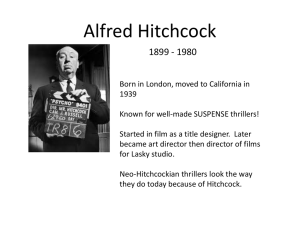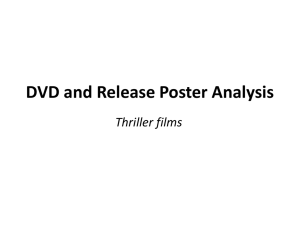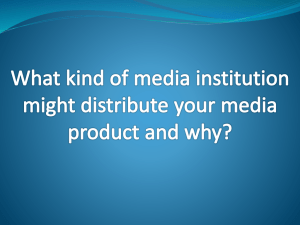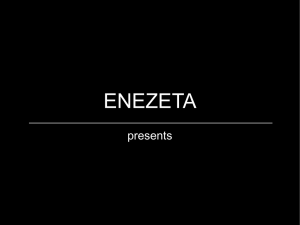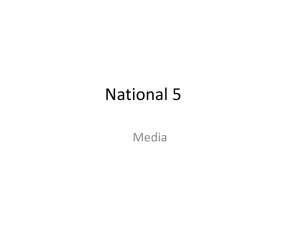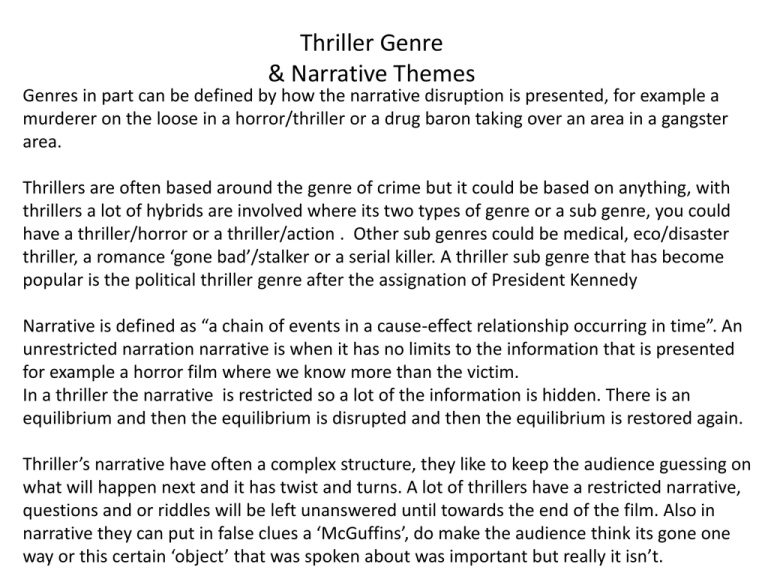
Thriller Genre
& Narrative Themes
Genres in part can be defined by how the narrative disruption is presented, for example a
murderer on the loose in a horror/thriller or a drug baron taking over an area in a gangster
area.
Thrillers are often based around the genre of crime but it could be based on anything, with
thrillers a lot of hybrids are involved where its two types of genre or a sub genre, you could
have a thriller/horror or a thriller/action . Other sub genres could be medical, eco/disaster
thriller, a romance ‘gone bad’/stalker or a serial killer. A thriller sub genre that has become
popular is the political thriller genre after the assignation of President Kennedy
Narrative is defined as “a chain of events in a cause-effect relationship occurring in time”. An
unrestricted narration narrative is when it has no limits to the information that is presented
for example a horror film where we know more than the victim.
In a thriller the narrative is restricted so a lot of the information is hidden. There is an
equilibrium and then the equilibrium is disrupted and then the equilibrium is restored again.
Thriller’s narrative have often a complex structure, they like to keep the audience guessing on
what will happen next and it has twist and turns. A lot of thrillers have a restricted narrative,
questions and or riddles will be left unanswered until towards the end of the film. Also in
narrative they can put in false clues a ‘McGuffins’, do make the audience think its gone one
way or this certain ‘object’ that was spoken about was important but really it isn’t.
Thriller History
Alfred Hitchcock who made very famous thriller films said his intention was “to
give the public a good healthy mental shake-ups”.
Alfred Hitchcock also popularized the use of a ‘MacGuffin’ with his 1935 film
‘The 39 steps’. A MacGuffin is used sometimes in the first scene to make the
audience feel it means something and is part of the narrative plot but then
later in the film its importance isn’t acknowledged any more and its used to
lead the audience astray.
Narrative Themes
•
Thriller’s narrative have often a complex structure, they like to keep the
audience guessing on what will happen next and it has twist and turns. A lot of
thrillers have a restricted narrative, questions and or riddles will be left
unanswered until towards the end of the film. Also in narrative they can put in
false clues a ‘McGuffins’, do make the audience think its gone one way or this
certain ‘object’ that was spoken about was important but really it isn’t.
• Tzvetan todorov’s Theory of Narrative
He suggested that conventional narratives are structured in five stages: A state
of equilibrium so for example in Collateral you see Max’s everyday life as a taxi
driver. Then a disruption of the equilibrium by some type of action or
happening. A recognition that there has been a disruption. An attempt to
repair the disruption, so in classic thriller the films the Protagonist has to
fight of the antagonist for the reinstatement of the equilibrium.
Narrative Conventions
•
Thrillers are often based around crime but not always, for example taken is under
the genre of a thriller but is not based around crime. It almost always has a
complex structure, it can have a lot happening at once and some information is
only found out right at the end of the film which sometimes leads to the audience
understanding the whole film. They can make the audience on edge the whole
time, making them ask questions, guessing what is going to happen next –
suspense.
• Different Levels
There can be the psychological experience so you can feel a wide range of
emotions varying from sad, happy, anxious all in one film.
You can feel the thrill of the film so the action and the violence and the danger can
make you feel thrilling and excited because it doesn’t happen in your everyday lfie.
Then there is the extraordinary happening in the ordinary so place/objects/people
all can become dangerous and thrilling filmed in a way to create fear and
suspense and excitement.
Characters
In thrillers there are several characters which usually are involved in the plot and
narrative, there is almost always a hero type character who is usually a man and they re
store the equilibrium. This person is probably just a normal everyday person who is ‘in
the wrong place at the wrong time’ or a police officer. Another word for this is a
Protagonist. Then there is the antagonist (villain) who creates the narrative disruption
and is usually psychotic but extremely clever. Then there is the victim who is usually a
female who is most threatened by the villain and they’re usually not really involved in
the whole crime situation. You also have the donor, the helper, the dispatcher and the
false hero. Not all of these necessarily have to be the main characters or even in it at all
but these are just the usual type of characters that re in the narrative.
Mise en Scene
Mise en scene is a term which describe the design features of a film
production. It basically means ‘telling a story’. So for example you
have the setting, location and set design and then props, costumes,
make-up, figure expression, facial expression, lighting and colour all
contribute to what makes up Mise en Scene.
In thrillers a lot of the things like for example the location/setting
can make it typical of that genre, so it can be anywhere but of
urban space so cities/towns. In the Film ‘Brick’ in the opening scene
of the film there are parts of it in a school, and school is meant to be
a safe environment, some where you feel secure and this can also
make your mind up about the characters, maybe they will be young
adults studying at high school,
just from one shot it sets the scene and
gives the audience answers .
Another mise-en-scene you typically find in
thrillers is the way the lighting/colour is.
Again in Brick the colour of the film is desaturated,
blue and there are a lot of shadows and light and shade, low key
type of colours. It creates a dull depressing mood as well as it
creating a black type of atmosphere, almost mysterious and eerie
which is crucial in a thriller for it to feel like that.
Mise en Scene
Costumes and Makeup - In Brick the clothes that the
people are wearing are quite bland and not very colourful
which tells you about the character and again about the
mood. The guy who receives the notes from his girlfriend
wears quite boring clothes which could also mean he is a
bit of an outcast from other people at his school, not really
‘in fashion’. It also does bring down the mood in the film, if
they’re wearing bright colours it brings quite a happy
mood.
Props – In films props can really contribute with the
narrative and in thrillers It can not only contribute to the
narrative but get the audience asking questions. It could be
a briefcase that is shown or a folder that is past over to
someone, something that obviously has significance to the
film. In Brick a note is in the guy’s locker from his girlfriend
telling him to meet him somewhere, it gets people asking
questions as to why she can’t just phone him or talk to him
face to face, yet she has to give him a note as a way of
contact.
Cinematography
• Shots that are typically used in a thriller is the extreme close up shot,
because with the person or object being so close up to the screen, right
into the viewers faces it can create suspense. With it being an object you
know that it could have significance to the main narrative of the film. Or
with it being a person, you can see clearly their emotions, which usually if
it’s a thriller could be fear. And with that character filling all the screen it
can make the audience watching it feel that emotion too.
For example in Collateral in the opening scene there is an close up shot of
Vincent (Tom Cruise) and it shows the audience that he has no emotion on his
face what so ever. You get a clear look of him and it also is for the audience to
clearly see his a key character in the film. He is wearing sunglasses which
could mean he doesn’t want to show emotion, and I think they do this shot to
give the audience clues as to what character he is going to be.
• Then you have the tracking shot, with this is can make the audience feel
part of the film, this shot is usually used when a big moment or dramatic
scene is happening, its good because it keeps the audience intrigued and
interested and part of the action, for example if the character is running
and the shot is used so it looks like the audience is running with the
character into danger.
Cinematography
A camera shot that is used a lot in thrillers is POV/APOV, what this does it puts
the audience in the shoes of the protagonist/antagonist. You basically see
everything that they see, and you get a feel of what they are feeling. They do this
in collateral where Max looks down at a photo and as he does this you get the
angle of what he is looking at, and you see a photo, this photo could imply
importance, and maybe important for the audience to know his character, he
could be a dreamer, or someone who works towards a goal.
There are different uses of camera angles, you have the high angle shot,
this can be used a lot in thrillers to make a target or even the criminal
getting caught look weak and defenceless. It can again make the
audience feel like the powerful one, because the camera is looking
down on the person who is defenceless. You then have the low angle
which shows you a view from below the person. The camera is looking
up at the person/object and it can make whatever that is look more
powerful and strong and the one in control.
Unconventional angles is gives the audience an uncomfortable view, this
can be used a lot in thrillers because they’re meant for the audience to
sometimes feel uncomfortable and on edge.
Sound and Editing
Sound
•
•
•
•
•
Volume – this is the level of sound so it could either be high or low. If it's an intense but
in a movie the volume might be quite low to make it feel quite chilling and se the mood
where as if its ‘happy’ movie the volume might be quite high to show how up beat it
is. In thrillers typically low volume will be used. If music is quite loud it takes away the
suspense of the thriller where as low music can create a tense atmosphere and
sometimes scary.
Pace – this is the speed of the music. So for example if its an action movie and there is a
high speed car chase the pace of the music would be quite fast just to match what is
happening on the screen. But if its in a film and it’s a sad scene the pace of the music
might be quite slow to bring down the mood of that scene. In a thriller if its leading up
to something big the pace could be quite fast and to make the audience feel like it’s
leading up to something and feel excitement.
The pitch describes the range of the sound
Timbre/tone describes the texture
Silence can be as a powerful to create a mood as sound. Having silence in a film can be
really intense and un-nerving especially in a thriller. You’re nervously waiting for the
next thing to happen, this can be a really good technique to draw the audience in.
sound
•
•
•
I looked at the opening title sequence of Donnie
Darko and studied the diegetic and non-diegetic
sounds and why they’re there. Starting off with
diegetic at the start of Donnie Darko you hear birds
which people most commonly take notice of when
you first wake up, it’s also quite a peaceful soothing
sound. There is some music in the opening title
sequence which is non-diegetic, at first it’s quite low
and slow and it sounded quite dark so it gives the
audience maybe the impression it’s going to be a
dark movie but when he gets on his bike this slow
type piano starts playing but in an upbeat way. So
it’s quite confusing as to what the genre of the film
is and what it’s going to be about.
Diegetic is natural sounds that occur in everyday life.
Non-Diegetic is sounds that have been placed in the
edit for example music.
Editing
•
Editing is a clever process of placing separate shots together because its so
well done most of the time you rarely even notice that it has been edited,
unless the director has done this intentionally. When the director does do this
its usually to create effect or emotion. Sometimes editing is used to tell the
audience something in the narrative.
Continuity editing
• Continuity editing helps the plot of the film rather than dominate it. It also
gives the impression that these edits are motivated, like its leading to
something. Almost all films use continuity editing. The Batman begins tumbler
scene, loads of different shots of the action cut together and makes up about
10 seconds of the filming but you get to see all of the action taken place.
Editing Content:
• A graphic match is where there is a similar relationship between the two shots
to make it look smooth.
• Graphic contrast is when the next shot it in contrast to the last show to create
impact.
Editing
Match on action
• This is when the cut is made on the action, for example when someone
jumps from one building to another the camera is on one side of it and
then the next shot is taken when the person lands on the other building,
its unlikely for the audience to take notice because its part of an action
scene.
Parallel Editing
It cuts from two different scenes that are going on at the same time but in
different places. For example in silence of the lambs when you think the
police are going into the Killers house but really they get an empty house but
as they’re ringing the doorbell of that house, the killers doorbell is also going
off so it gives you false information about who is actually at the door.
Detailed Analysis on the open
title sequence of Collateral
Mise en scene
Collateral starts off at a public place which you then find out is an airport and then it
switches to a taxi rank, both set in LA. Thrillers usually take place in a big city where action
takes place. With them being in a public place people like Vincent (Tom Cruise) can blend in
and not be noticed and discreetly do their job. It makes you wonder what other criminals are
blending in the bust atmosphere. Vincent stands out in the crowd by blurring out the other
faces of on going people to show that they aren’t important and that the audiences attention
With him wearing glasses it
should be on Vincent.
shows that he is intelligent, and
Wearing sunglasses
his intelligence is wasted on
hides his emotions,
being a taxi driver.
you can tell by what
people are feeling by
looking in their eyes,
so he is mysterious
and hidden.
The suit is quite sharp
and clean cut, he is
smart and takes his
The grey hair and grey suit could mean he doesn’t job seriously. It also
looks expensive so he
want to stand out, they’re quite bland colours.
has a well paid job.
Max is wearing quite bland
colours it could be putting across
he can’t afford nice clothing.
Mise en scene
Props
This briefcase are typical of the genre because they
add mystery and gets the audience asking
questions. The briefcase adds to the actions
because it stands out and signifies importance.
The crossword again puts across
Max’s intelligence. Also it could
show he is antisocial because the
other cab drivers are talking and
socialising.
He might have an OCD
about everything being
clean, and making the taxi he
is using his own.
Describe actors’ performance
Body Language/accent/paralanguage Key phrases etc.
Vincent’s body language is quite cool and laidback, normal type of body
language, so he isn’t noticed. When he bumps into the guy so it looks like
an accident he say’s to the guy ‘You OK?’, with a nod so you can tell he is
implying something else. You can tell Vincent is of a high status with how
confidently he walks and talks. The difference with him and Max’s body
language is Max’s body language is quite lazy and slouchy almost like he
can’t be bothered. This can maybe mean he is of a lower class because he
doesn’t seem confident in his actions. This can show also that he is in sort
of his own world he isn’t phased or bothered by what goes on around him
almost like he is in a constant daydream.
Cinematography
The same with the other
character, surroundings are
blurred to show his importance
in this scene.
This medium shot of Vincent
walking through the crowd,
with his surrounding's
blurred shows the audience
that he is a key character. It
also gives the audience a
clear look of him to see his
character type for example
what he is wearing, how he
is walking etc.
The close up of the bag, could
be to tell the audience it is a key
prop in the film and it implies
mystery and you want to know
what is in there. Gives you a
taste of what is to come.
There is a low angle of Max which can
show he could be a powerful
character in the narrative to come and
shows the importance to him
APOV (associated point of view), the rest
of the surrounding are blurred out again
and it is in focus of one half of Vincent’s
face. It adds mystery to him because you
can only see one half of his face plus the
sunglasses really makes him an
unreadable character.
•
•
•
Gender wise both Men and Women enjoy thrillers, they each have similar and different aspects
that they enjoy from thriller films. The Target audience would be starting from young so around 15
– 30 year olds and then from middle age so 30-50 year olds, I think typically enjoy thriller films the
most. Reason being that I think older people will not enjoy these type of genre of films, they might
even find it offensive. Men enjoy thrillers I think for the suspense the way you’re on the edge of
your seats and mystery but also for the action e.g. Violence, car chases. They find excitement in
this maybe because its not in their every day life. Woman I think enjoy thrillers because of the
suspense, mystery but also for the typical strong male lead. E.g. Brad Pitt, Leonardo DiCaprio. They
like a break from reality. I think this goes the same with teenage boys and girls but obviously
everyone has different opinions on why they watch thrillers but I think this is the typical view.
Because most thrillers are rated 15-18’s the target audience does start at 15. Sometimes thrillers
are 12’s but because thrillers do usually involve a lot of graphic violence which some young viewers
aren’t suitable to watch. Also they can involve a lot of swearing and possible sexual nature. These
are usually above the rating of a 15 but if its not frequent it can be rated a 15.
I think Men maybe prefer the thrillers such as The Dark Knight rises because it does hold a lot of
action and violence and the thrill of that, but personally woman do enjoy those type of films as well
but I think they prefer the more crime and mystery films such as Drive and Taken. Again men do
enjoy these films as well.
Sub genre Taken is an action/crime/thriller film.
Certificate 15
Drugs
Drug taking may be shown but the film as a whole must not promote or encourage drug misuse.
The misuse of easily accessible and highly dangerous substances (for example, aerosols or
solvents) is unlikely to be acceptable.
Taken – The woman who are taken by sex traffickers are put in drugs to make them tired.
Violence
Violence may be strong but should not dwell on the infliction of pain or injury. The strongest gory
images are unlikely to be acceptable. Strong sadistic or sexualised violence is also unlikely to be
acceptable. There may be detailed verbal references to sexual violence but any portrayal of sexual
violence must be discreet and have a strong contextual justification.
Taken – The violent scenes in taken are strong and there are a lot of them, most scenes do involve
some type of violence, a lot of the violence isn't majorly graphic and horrible but there are a few
scenes where it can be quite uncomfortable to watch e.g. when he is electrocuting the man in the
chair.
Sub genre The Dark Knight Rises is an Action/Crime/Thriller film.
Certificate 12A
Violence
Moderate violence is allowed but should not dwell on detail. There should be no emphasis on injuries or blood,
but occasional gory moments may be permitted if justified by the context. Sexual violence may only be implied
or briefly and discreetly indicated, and must have a strong contextual justification.
Dark Knight Rises – There are a lot of scenes of violence in Dark Knight Rises but it isn't constant through out
the whole film and a lot of the violence isn’t amazingly graphic.
Language
Moderate language is allowed. The use of strong language (for example, ‘fuck’) must be
infrequent.
Dark Knight Rises – There are a few scenes in The Dark Knight Rises with strong language but this
is infrequent so it’s acceptable for this movie rating.


